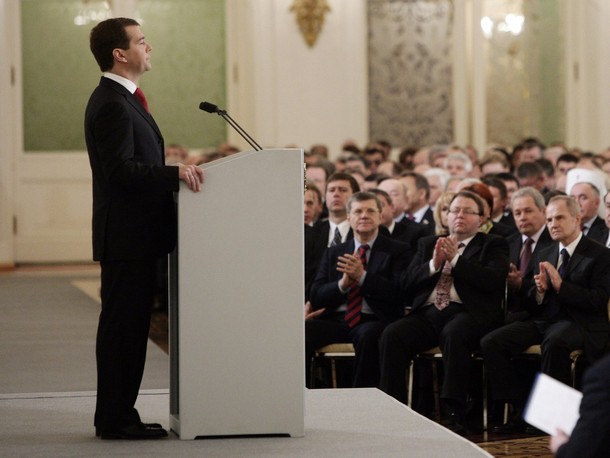
Medvedev Sets Targets for the Russian Defense Industry
Publication: Eurasia Daily Monitor Volume: 6 Issue: 212
By:

Russian President Dmitry Medvedev, during his address to the Federal Assembly in Moscow on November 12, again highlighted the need to equip the armed forces with modern weapons and equipment. In the context of a lengthy, wide ranging speech which developed the theme of modernizing the Russian economy, first elaborated in his article “Go Russia!” on September 10, it was unsurprising to find this initiative being applied to the military. However, Medvedev was quite specific, saying that next year the defense industry must supply “more than 30 ballistic land and sea-based missiles, 5 Iskander missile systems, about 300 modern armored vehicles, 30 helicopters, 28 combat aircraft, three nuclear-powered submarines, one corvette-class warship and eleven spacecraft” (www.kremlin.ru, November 12).
Medvedev’s military priorities, which he briefly set out in his speech, were essentially a restatement of his position outlined during his meeting with the defense ministry collegium on March 17. Then, he noted that modernizing the weapons inventory was the most critical challenge facing the armed forces and declared that large-scale rearmament would begin in 2011 (www.kremlin.ru, March 17). In October, he publicly chastised the defense industry and demanded its modernization (EDM, November 3). Yet, his address to the Federal Assembly implied that he wants to see the armed forces developing network-centric warfare capabilities that presently seem some time away. By specifying clear procurement targets on November 12, he perhaps hopes to stimulate the transformation of the defense industry through formulating a benchmark against which its performance might be assessed.
The Russian defense industry is certainly taking note of the increased pressure from the Kremlin, yet the time lag in developing new systems and equipment may cause considerable problems. Indeed, this was inadvertently highlighted in a series of articles in the Russian newspaper Vremya Novostei on September 22-25 and October 29 examining the defense industry’s efforts to meet the needs of future warfare. Particular attention was paid to “innovative” developments both domestically and abroad.
Work carried out by the Central Scientific Research Institute “Armokom” was singled out as exemplary. Responding to an order from the defense ministry, Armokom has developed a high-technology camouflage suit, offering optical-visual, optical-electronic and radar protection. The suit apparently protects against radar reconnaissance systems using a radar-absorbing material called bicarbalon, weighing one kilogram its test model costs 7,000 rubles ($240) –though this would be reduced as a result of serial production. This was successfully tested, with Russian reconnaissance systems allegedly unable to detect its wearer against the backgrounds of a forest or open field. Unfortunately, this appears based on technology developed fifteen years ago, and now revamped and presented as new. Its critics claim that it only functions adequately within a narrow range of wavelengths and works against a small number of radar surveillance systems. The company is apparently also closely following research being conducted by the “Mogoteks” enterprise in Mogilev, Belarus currently testing a new fabric that renders suits impossible to detect using night vision equipment (Vremya Novostei, October 29).
Armokom has had some innovative success in developing a prototype protective shell for spacecraft, and surely the type of innovation that Medvedev wants to promote. The secret technology replicates the properties of human skin, enabling it to self-repair after a small cut; the practical application will be to use this as a protective coating against space debris and micrometeorites. Nevertheless, the work remains in its early stages, and is unlikely to be introduced for some time (Vremya Novostei, October 29).
Moreover, the prolongation of research and development schedules is common even where the need is more acute. For example, the Speech Technologies Center (TsRT) in St. Petersburg has designed an advanced digital audio recorder, or so-called black box, which is planned for fitting onboard all fourth generation submarines. The Tserber (named after the mythical Greek multiple-headed dog) is 20-30 centimeters in length, compared with the one meter long cabinet which contained instruments recording on magnetic tape, using new technologies: static, digital information media with a removable flash drive. It has an acoustic launch, triggered by human voice or while using special acoustic algorithms, with a capacity to record up to 850 hours on 14 digital recording channels, the device is secured to shock absorbers to offer resistance against blows or vibrations. Nonetheless, the defense ministry placed this order in 2000 in the aftermath of the Kursk tragedy. Yet, despite the length of time involved in its development, TsRT is evidently proud of their achievement displaying it at the annual Milipol arms show in Paris on November 17 (Vremya Novostei, October 29; www.speechpro.ru, November 10).
While Medvedev decorated Mikhail Kalashnikov at a ceremony in the Kremlin on November 10 marking the ninetieth birthday of the AK47’s inventor, it appears that there is some interest in the new XK-11 multipurpose next generation rifle manufactured by S&T Daewoo in South Korea and being introduced this year in small quantities into their armed forces. It is equipped with a computerized targeting system, capable of simultaneously discharging bullets and an under barrel grenade. While interested in the characteristics of the weapon, its estimated cost of $16,000 per rifle, makes even the idea of developing a Russian version quite daunting (Vremya Novostei, October 29; RIA Novosti, November 10). There are clearly more pressing needs.
In general terms, Medvedev’s promotion of a modernized economy that encourages a culture of innovation is sorely needed within the ailing defense industry. While new technologies are so painstakingly developed, these are the exception rather than the norm. It took nine years to digitize the black box for fourth generation submarines, yet Medvedev wants this process accelerated in overhauling communications systems in the armed forces: “Before 2012 we need to replace outdated analogue communications equipment with digital systems, and give priority in equipping with these modern communications means to the troops of the North Caucasus Military District,” he asserted (www.kremlin.ru, November 12). By prioritizing the North Caucasus, an area in which conflict is more likely, he may hope to strengthen conventional capabilities within this military district, while more slowly rearming the remainder of the force.




